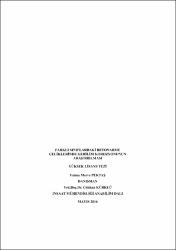| dc.contributor.advisor | Kürklü, Gökhan | |
| dc.contributor.author | Pektaş, Fatma Merve | |
| dc.date.accessioned | 2019-05-27T10:46:41Z | |
| dc.date.available | 2019-05-27T10:46:41Z | |
| dc.date.issued | 2016 | |
| dc.identifier.uri | http://hdl.handle.net/11630/6216 | |
| dc.description | Reinforcing rebars are formed by bending to ensure adherence and placing the suitable position in reinforced concrete elements. During this process, stress occurs on reinforcement rebars. This stress will affect the corrosion mechanism. In this study, stress corrosion in different classes reinforced concrete were searched and also three different bending angles (45, 90, 135°) were used while forming reinforced concrete rebars and stress free situation was considered. 12 mm diameter reinforcement rebars were used in this study. As a reinforced rebar category flat S220, ribbed S420 and tempcore ribbed B500C rebar class were used. Normal concrete which does not contain any mineral additives and additive concrete which contains %25 fly ash substitutions were used. Corrosion process was considered from three different perspectives which are in terms of concrete, in terms of reinforced bars and in terms of reinforced concrete. Fly ash additive caused %4 reduction of concrete strength but it increased corrosion resistance between %20 and %62. If the bending angle increases, the corrosion rate increases. Tempcore ribbed B500C showed the highest corrosion resistance and the lowest corrosion rate behavior in the class of reinforcements rebars. | en_US |
| dc.description.abstract | Betonarme elemanlarının imalatında kullanılan çelikler, uygun konumda yerleştirmek ve aderansı sağlamak amacıyla bükülerek şekillendirilirler. Bu işlem sırasında çelik donatı üzerinde gerilme oluşur. Bu gerilme durumu da korozyon mekanizmasına etki edecektir. Bu tez çalışmasında, farklı sınıflardaki betonarme çeliklerde gerilim korozyonu araştırılmıştır. İncelemede inşaat çelikleri şekillendirilirken kullanılan üç farklı bükme açısı (45, 90, 135°) ile gerilimsiz durum ele alınmıştır. Çalışmalarda 12 mm’lik S220 düz, S420 nervürlü ve B500C tempcore nervürlü çelik sınıfı donatılar ile mineral katkı içermeyen normal beton ve %25 uçucu kül ikamesi yapılan katkılı betonlar kullanılmıştır. Korozyon sürecinde beton açısından, çelik açısından ve beton ile çelik beraber olmak üzere üç farklı açıdan ele alınmıştır. Uçucu kül katkısı beton dayanımının %4 azalmasına sebep olmuş buna karşın korozyon direncini %62 ila %20 arasında arttırmıştır. Korozyon hızı bükme açısı arttıkça artmaktadır. Çelik sınıflarından en yüksek korozyon direnci ve en düşük korozyon hızı davranışını B500C çeliği sergilemiştir. | en_US |
| dc.language.iso | tur | en_US |
| dc.rights | info:eu-repo/semantics/openAccess | en_US |
| dc.subject | Gerilim korozyonu, uçucu kül, tempcore, betonarme donatısı | en_US |
| dc.title | Farklı Sınıflardaki Betonarme Çeliklerinde Gerilim Korozyonunun Araştırılması | en_US |
| dc.title.alternative | Investıgatıon of Stress Corrosıon in Dıfferent Classes Reınforced Concrete | en_US |
| dc.type | masterThesis | en_US |
| dc.identifier.startpage | 1 | en_US |
| dc.identifier.endpage | 97 | en_US |
| dc.relation.publicationcategory | Tez | en_US |



















